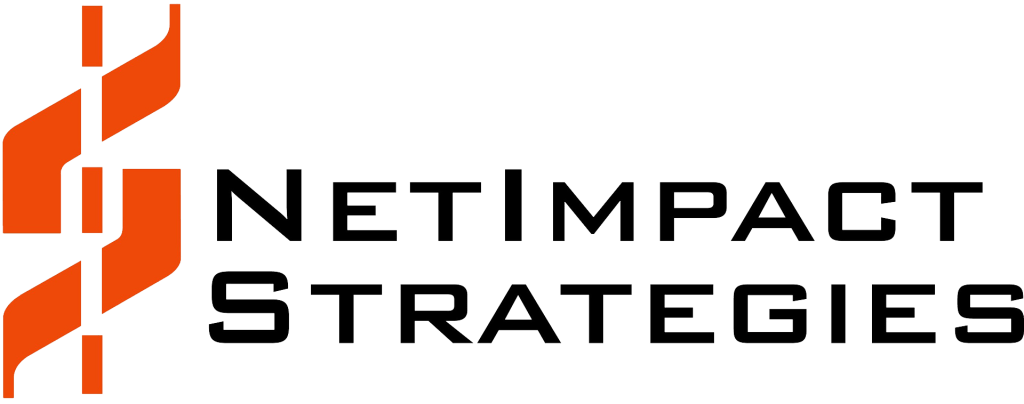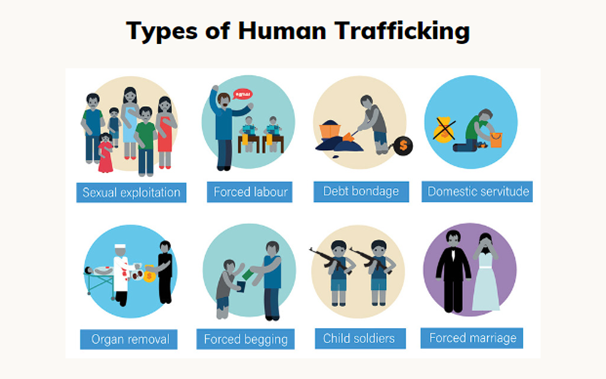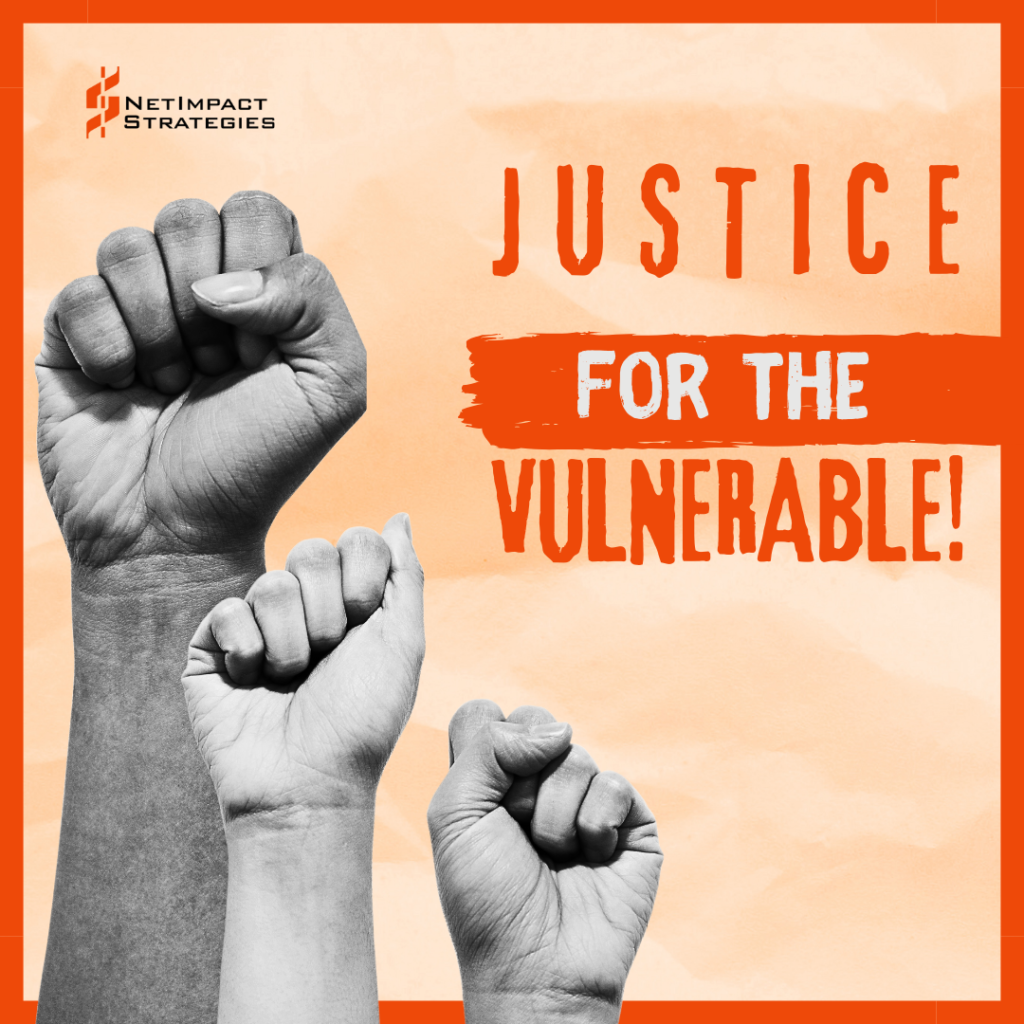The Department of Justice’s (DOJ’s) Bureau of Justice Statistics (BJS) reports[i] that the number of people prosecuted for human trafficking increased from 729 in 2011 to 1672 in 2022, indicating an increase of over 125%. Human trafficking is a kind of modern-day slavery affecting an estimated 27.6 million victims globally[ii].
Victims of trafficking are often forced or pressured to work in exploitative and dehumanizing conditions, such as prostitution, domestic servitude, or agricultural labor. Traffickers are trained to identify victims and their vulnerabilities and often lure them through false promises of well-paying jobs, a diverse range of manipulation tactics, or other dishonest relationships. Human Traffickers are also well-versed in violence, with studies showing that females between the ages of 18 and 24 experience a higher prevalence of physical and sexual violence[iii]. The other common factor identified in the analysis of the Victim of Trafficking Database (VoTD) was that violence was significantly associated with a self-reported high socio-economic status of these girls.
In 2021, the National Human Trafficking Hotline received 51,073 tips on potential sex/labor trafficking situations with 16,710 victims involved in identified cases.
Human trafficking has no place in society. It’s a crime that undermines labor standards and breeds corruption and economic inequalities that spread through communities. It severely damages and erodes trust and security, by exploiting dignity and disregards fundamental human rights. According to a 2022 report[iv], approximately 28 million people were victims of modern slavery. Trafficked victims, including children, often endure physical, psychological, and emotional abuse as well as denied access to basic necessities. These acts include assault and torture, rape and forced drug use, physical confinement and/or restraints, threats against loved ones, document and debt bondage, humiliation and intimidation, and denial of water and medical attention. Behind each victim lies a heartbreaking narrative of the completely shattered lives of the victims and their families. After suffering a terrifying life full of exploitation and the neglect and denial of basic human rights, rescued victims must navigate the world through tremendous trauma.
This dark but true reality calls for an urgency for justice – a hope for those who have been exploited, silenced, and kept voiceless. In the quest for justice for the exploited, law enforcement agencies work tirelessly to unravel the complexities of human trafficking. Investigators and caseworkers serve as a single point of contact for the victims. They can access victim’s needs for services and support and coordinate those services, manage communications across systems, and ensures justice for victims of human trafficking, by offering a coordinated and comprehensive approach to victim support. The support involves law enforcement, social service providers, medical providers, prosecutors, mental health professionals, housing providers, childcare providers, and public benefits personnel working together to ensure that victims have access to the services, e.g., medical care, mental health counseling, legal assistance, and safe housing.
Current State of Human Trafficking Investigation
Contrary to the misconception that human trafficking is restricted to third-world countries, it is a pervasive issue globally, including several developed countries. It’s not just countries like India, China, or Vietnam that bear the brunt of this scourge. In fact, the United States is one of the top destinations for human trafficking victims. In 2021, the U.S. attorneys referred 2,027[v] persons for human trafficking offenses, reflecting a substantial 49% increase from 2011.
Human trafficking is a complex, hidden crime where victims rarely come forward to seek help because of the complex factors involved, e.g., language barriers, insecurity, fear of the traffickers, fear of law enforcement, fear of further societal ostracization, and many more.
The United Nations Office on Drugs and Crime’s (UNODC) Global Report on Trafficking in Persons[vi] analyzed data gathered from 155 countries and reported that around 80% of human trafficking happened in the form of sexual exploitation, primarily affecting women and girls. The remaining 20% is in the form of forced labor. These statistics underscore the urgency of addressing this pressing concern on a global scale.
How Does Exploitation Happen?
Traffickers exploit the vulnerabilities of their victims to control and manipulate them. The trauma caused by the traffickers can be so great that many may not identify themselves as victims or ask for help, even in highly public settings. There are several factors that can make individuals vulnerable to human trafficking, like:
Poverty: One of the major risk factors for human trafficking as it can make one more desperate and force them to take risks to improve their lives.
Emotional vulnerability: People who face emotional challenges are more susceptible to manipulation and control by traffickers.
Lack of education: Victims often have limited education or lack access to basic education, making them effortlessly manipulated and less aware of their rights.
Social marginalization: Discrimination or being part of a minority group or being against, can make individuals more vulnerable to exploitation.
Gender inequality: Women and girls are disproportionately represented among victims of human trafficking. Gender inequality can make them more vulnerable to exploitation, as they may have fewer opportunities for education and employment.
Natural disasters: Natural disasters create financial loss along with liability on victims. Due to this liability and burden to take care of families, victims easily fall preys among traffickers.
Disability: People with disabilities may be more vulnerable to human trafficking due to discrimination, lack of access to services, and limited mobility.
Children: Children are especially vulnerable to human trafficking due to their age, lack of power, and dependence on others. Conflict and displacement: Conflict and displacement can create conditions that make individuals more vulnerable to human trafficking, as they may be desperate for work and have lost their support networks.
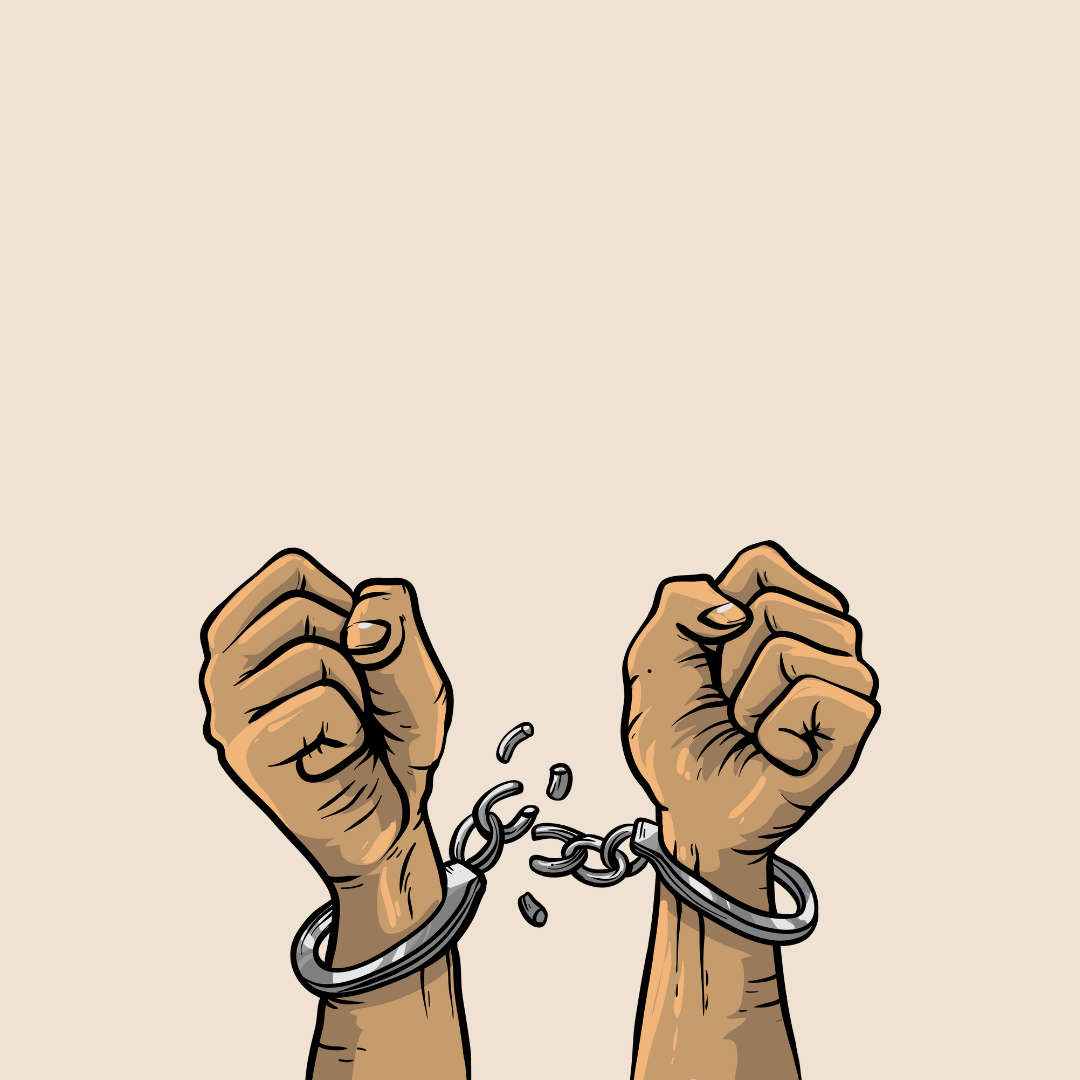
Tonya’s Story
Tonya’s life was turned upside down when she met Eddie in Texas at the age of 13. Their relationship started off casually, but soon Eddie began to coerce Tonya into forced prostitution. Night after night, she was exploited and abused.
The Department of Homeland Security’s (DHS) Special Agent Keith Owens intervened, and Eddie was finally arrested. Tonya testified against Eddie, and he was sentenced to 12 years in prison.
Now, Tonya is focused on rebuilding her life. She aspires to get an education and live a normal life. Her message to other survivors is that they are not alone and that they are worth something. She is a testament to the strength that is needed to escape the shadows of trafficking.
Challenges in Human Trafficking Cases
Human trafficking is an intricate and challenging crime to investigate and prosecute due to a range of factors. Sometimes, it’s because of the hidden nature of crime as trafficking usually occurs in hidden settings which makes it difficult to detect and investigate. Traffickers operate usually in secrecy and threats to control their victims, who may be too afraid to come forward or may not even realize they are being trafficked. Another reason is victims often lack trust in law enforcement, leading to underreporting of human trafficking cases. This reluctance hampers investigations as many instances go undocumented.
Traffickers also use technology to facilitate their operations, making it challenging for law enforcement to track and monitor their activities. The use of encrypted communication and the dark web adds an extra layer of complexity. Human trafficking often involves crossing international borders, making it difficult to investigate and prosecute. Traffickers may move their victims from country to country to avoid detection or exploit different laws and jurisdictions. The laws governing human trafficking vary from country to country, and there is often a lack of harmonization and coordination between different jurisdictions. This can make it difficult to investigate and prosecute cases effectively. Investigating human trafficking cases can be resource-intensive as well, requiring significant time, effort, and expertise. This can be a challenge for law enforcement agencies, particularly in countries with limited resources.
Addressing these challenges necessitates collective awareness, extensive training, and enhanced collaboration among various stakeholders. The resource-intensive nature of investigating human trafficking demands significant time, effort, and expertise, posing challenges for law enforcement agencies, particularly those with limited resources.
Preventing human trafficking requires a comprehensive strategy targeting the root causes such as poverty, lack of education, and gender inequality. This complex and long-term challenge calls for collaboration between governments, communities, and international organizations, highlighting the urgent need to safeguard the vulnerable and dismantle the structures enabling human trafficking.
Multifaceted Approach
The Department of Justice’s report, revealing an 80% increase in prosecutions, signifies progress in a battle against a crime that perpetuates modern-day slavery. Yet, the haunting reality persists, echoing the voices of millions ensnared in exploitation. As we navigate this challenging terrain, stakeholders must actively engage with survivors, listening, learning, and elevating the voices of those with lived experiences.
The complexity of human trafficking investigations necessitates specialized training for law enforcement and prosecutors, emphasizing the need for a nuanced understanding of the crime’s intricacies. Federal agencies underscore the importance of collaboration and effective information sharing to enhance case management, identify victims, and hold traffickers accountable. In pursuit of this, agencies employ a multifaceted approach to tackle the issue of human trafficking, encompassing prevention, investigation, prosecution, and victim support. Central to this effort, the Trafficking Victims Protection Act of 2000 (TVPA) [viii], enacted in 2000, is a landmark U.S. legislation aimed at combating modern forms of slavery. The TVPA established the “3 Ps” framework: Protection, Prevention, and Prosecution. It provided increased protections for trafficking victims, strengthened prevention efforts globally, and enhanced the prosecution of human traffickers. Examples of efforts underway include:
Protection
There are several anti-trafficking actors constantly working towards supporting the victims of human trafficking and providing the help they need, such as the National Human Trafficking Hotline[ix] and the National Human Trafficking Resource Center (NHTRC)[x]. NHTRC a 24×7 toll-free hotline available to answer calls from anywhere in the country, operates independently of law enforcement, is funded by the federal government, and is managed by a non-governmental organization. Organizations like the University of Maryland Support, Advocacy, Freedom, and Empowerment (SAFE)[xi] Center for Human Trafficking Survivors contribute significantly. SAFE Center empowers survivors through survivor-centered services and research-based advocacy.
| The National Human Trafficking Hotline plays a pivotal role by maintaining one of the most extensive data sets on the issue of human trafficking in the United States. In 2021, it received over 50,000 signals, including 13,000 from victims. Also, more than 10,000 cases were identified in that year, out of which approximately 16,000 victims were involved in these cases, as one case can involve multiple victims. |
Prevention
The Office of the Assistant Secretary for Health (OASH), and the Office on Women’s Health (OWH) are addressing human trafficking prevention among women and girls in the United States through the HHS Innovation Challenge[xii]. The Maryland Human Trafficking Task Force (MHTTF)[xiii], the state’s primary organization, strives to prevent trafficking, protect victims, prosecute traffickers, and build partnerships to eliminate human trafficking from our communities.
Prosecution
Investigative case management (ICM) for human trafficking demands collaboration among various federal agencies to enable each organization to contribute unique expertise and capabilities. By working together, these agencies can share information, coordinate investigations, and pool resources to identify and apprehend traffickers, rescue victims, and dismantle trafficking networks.
Investigative case management (ICM) provides a structured approach that improves the coordination and effectiveness of investigations, ensure that victims receive the support they need, and hold traffickers accountable.
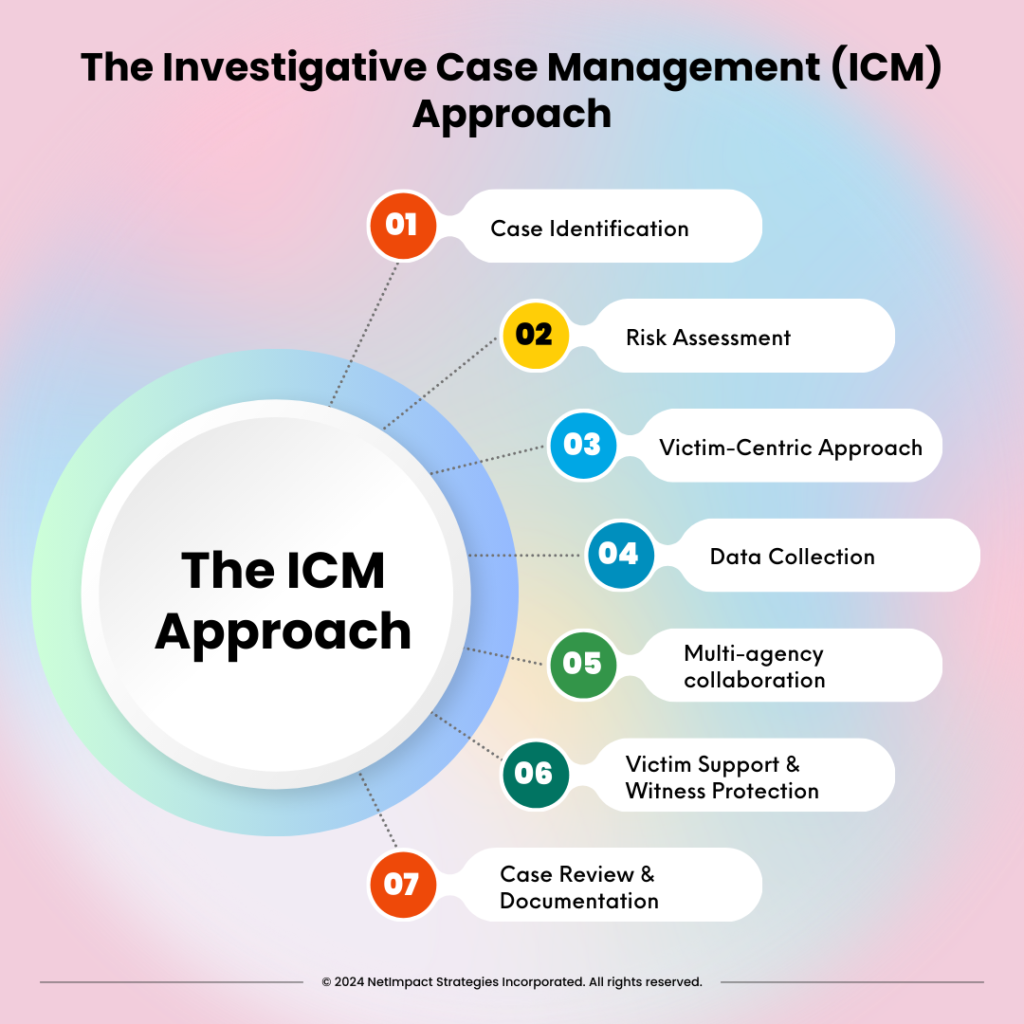
Sharing information between agencies is essential for improving case management in human trafficking investigations. When agencies share information about victims, suspects, and trafficking patterns, it can lead to more effective investigations, better identification of victims, and more successful prosecutions.
Recognizing the criticality of information sharing and case tracking to streamline the investigation process, agencies have invested in cross-organizational modernization initiatives. The Department of Homeland Security’s (DHS) Immigration and Customs Enforcement (ICE) department performed major updates in 2021 to their Investigative Case Management (ICM) that facilitated information and records sharing with Customs and Border Protection (CBP).
Empowering Change for a Collective Effort Against Human Trafficking
Making greater strides in improving how we tackle human trafficking requires reshaping our investigative approach from the ground up. It involves breaking down silos, prioritizing victim welfare, investing in ongoing education, and embracing technological advancements to create a formidable force against this grave injustice.
Victims are Humans, Not Evidence
Too often, victims find themselves at the periphery of investigations, treated as evidence rather than individuals with harrowing stories. Adopting a victim-centric approach that is grounded in comprehensive victim support, we not only empower survivors but also gain invaluable insights that can lead to the dismantling of trafficking operations.
Moreover, this transformation necessitates a commitment to training and education. As trafficking methods evolve, law enforcement must be equipped with the latest tools and techniques. Continuous learning programs can ensure investigators stay ahead of traffickers, employing innovative methods to track, intercept, and bring to justice those who perpetrate these heinous crimes. Investments in public education can also help scale our nation’s ability to identify criminal tails or risk factors for preventative measures.
The Indicator Card[xiv] from DHS is available in almost 40 languages and provides basic education, an easy-to-reference list of common indicators of human trafficking, and reporting action.


Technology should be Tools, Not Tasks
Technology can play a significant role in enhancing the process of investigative case management (ICM) for human trafficking prosecutions. By leveraging technology and data-driven approaches, ICM can become more streamlined, victim-centric, and effective in bringing traffickers to justice. Technology can equally play a significant role in hindering ICM.
Traditional investigative software is bulky and operates in silos. Largely because they have historically been developed in silos as well. Deployment and maintenance undergo lengthy software development cycles and cumbersome cybersecurity processes – both of which disrupt the flow of crucial information and impede the collaborative efforts needed to dismantle complex trafficking networks. A paradigm shift requires the integration of cutting-edge technologies, fostering an environment where law enforcement agencies can share real-time data seamlessly and the solution remains adaptive to dynamic needs that evolve with our ICM maturity and investigative processes and partnerships.
| Tools like DX360°® Investigative Case Manager offer mobile portability, features that simplify the entire case lifecycle, and the secure scalability of Microsoft 365 and Azure. Reducing administrative burdens by over 20%, this intuitive app automates and extends investigative capabilities to cover intake, evidence collection, analysis, communication, interviews, document management, and reporting. With no-code, low-code responsiveness and flexible integrations empower federal agencies and partners to collaborate on investigations, elevate victim support, and fortify their response to human trafficking, ultimately bringing traffickers to justice and safeguarding vulnerable individuals. |
Collaborative platforms that enable local, national, and international agencies to share securely insights and intelligence in real-time are pivotal. The ability of these platforms to remain responsive to cybersecurity and mission needs also contribute to the solution’s utility. When our time is spent more on managing the tool instead of the cases, our investments become a disservice to the victims. These platforms should improve the lives of investigators and support their emerging needs while facilitating the seamless exchange of information, fostering a collective intelligence that transcends borders and jurisdictions.
Data tells Stories, Not Snapshots
When there is a lack of coordination between agencies and their law enforcement partners, investigations become fragmented – creating conditions that make the data work for the criminal, and not the investigators. Effective ICM mitigates this by facilitating seamless information sharing and streamlining the investigation process. This collaborative approach not only enhances the quality of intelligence analysis but also ensures a more comprehensive understanding of trafficking networks, their tactics, and key patterns. With emerging capabilities like artificial intelligence and machine learning (AL/ML), we also introduce opportunities to take monumental strides in the accuracy and speed of our investigations. These advancements can shift through vast amounts of data, identify patterns, and predict potential trafficking activities, significantly enhancing the efficiency and efficacy of investigations. Preparing to take advantage of these advancements starts with improving how we collect and exchange data and viewing information sharing through the perspective of intelligent analysis and storytelling.
The Time to Change was Yesterday
With a modern society characterized by rapid technological advancements, globalization, and complex socio-political dynamics, the need to embrace change has never been more pressing. A fundamental shift towards innovative case management not only streamlines operations but empowers law enforcement with the tools needed to combat the intricate web of human trafficking networks. By embracing cutting-edge technologies, collaborative platforms, and a proactive, victim-centric methodology, we can rewrite the narrative, ensuring that every case becomes a story of rescue, resilience, and the triumph of justice over darkness. It’s time to not only investigate but to inspire change — to stand as a united front against the scourge of human trafficking and safeguard the inherent dignity of every individual.
Learn more about DX360°® Investigative Case Manager (ICM) by requesting a personalized today: demo@netimpactstrategies.com
